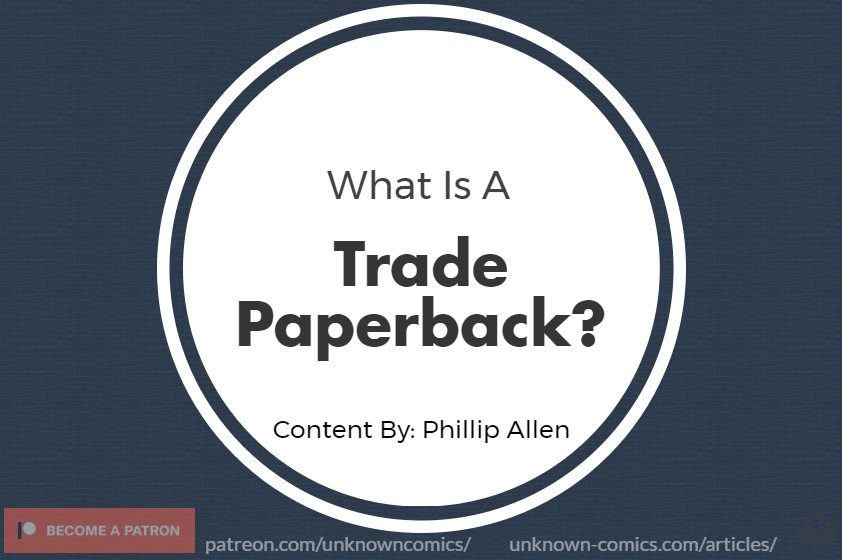Before we begin I’d like to make clear that This article will be detailing just what is a trade paperback. How it relates to other of comic mediums; specifically how it differs from graphic novels. I’ll also bring up a specific case scenario that can help explain why sometimes the definitions can begin to get confusing.
At the end of this article, I will be introducing some new terms that I feel will better define trade paperbacks into two separate categories. This should help clarify any possible misunderstandings when trying to market and sell one’s comic.
How It Relates To Other Comic Mediums
Trade paperbacks are typically confused with comic books and graphic novels. Not so much with manga.
Web comics that get printed are a different story. I promise to write something about that later.
But first…
Comic Books
Things start getting difficult when discussing limited or ongoing series, comic books or graphic novels. If you remember my opinions on trade paperbacks I prefer to associate the term with comic books. My reason is simple.
If you recall, limited and ongoing comic series have a tendency to bound a chapter (more common for ongoing series) or the entire series (typical for limited series) into a single publication once said chapter or series has ended.
Comic retailers, do keep in mind that there are different types of them, can find it easier to sell trade paperbacks. That’s because a significant number of readers prefer reading a chapter or an entire story in one publication.
Graphic Novels
Graphic novels are a single installment. Meant to be published as a single bound book. At least, that is how the writer usually intends it to be.
Like the article so far? Support the production of more articles like this one!
Now, Let’s Get Confusing
In the world of comics, things aren’t always so simple. Anything from funding running short to conditional offers being made by potential publishers can change the plans for comic’s planned publication.
Stuttered Publication
Take CJ Standal’s graphic novel Rebirth of the Gangster as an example (see Independent Publishing With CJ Standal for more). Due to lack of initial funding and no offers from publishers to help out with the production of his graphic novel, CJ was forced to break apart his book into multiple publications.
The publications ended up sharing many characteristics with a limited series comic book.
Publishers, most often independent, may do this in order to save costs. Shorter publication are easier to fund (see Funding Options for Comic Creators and Selecting the Right Crowdfunding Tools for more info) due to cheaper production costs (i.e. paying the artist, printing, etc.).
Another reason why publishers go this route is so that they can gain revenue from the comic’s sales to further fund their comic. If necessary revisiting funding options can be done to fill in the costs gap for further publications.
Back To Why It’s Still A Graphic Novel
- A Comic should be considered a Graphic Novel when:
- The final product’s characteristics meet the definition of a Graphic Novel AND
- The final product is a single bound book AND
- The creator ALWAYS intended it to be read as a single publication.
- It should be considered a Trade Paperback when:
- The separate publication’s characteristics meet the definition of a limited or ongoing series comic book AND
- The final product ends in multiple issues being bound into a single OR multiple books.
So, What Types Of Trade Paperbacks Are There?
I’d argue that there are two types of trade paperbacks:
- Limited Series Trade Paperback (LSTP)
- Ongoing Series Trade Paperback (OSTP)
Limited Series Trade Paperback would define limited series comics that ended up being bound in one or more publications.
Ongoing Series Trade Paperbacks would define the multiple publications of various chapters in an ongoing comic series.
Conclusion
I believe that it’s important to have clear lines in the sand when using specific terms for different comics. Having a common language in any industry is vital for reliable distribution of goods and services.
Having a clear understanding of what is a trade paperback and how it differs from a graphic novel can help when trying to sell one’s comic to a retailer.
Consider using these new terms, LSTP and OSTP), when trying to sell trade paperbacks to retailers. Now you should be able to clearly explain just what you’re selling to them and they can start to develop strategies for selling your work to new and existing readers.
Sign Up For
The Unknown Times!
Content Updates
Website News
Recommended Reading
And More to Come!
*Once every two weeks!*
Liked the article? Become part of my Patreon Community!
About The Author

Phillip Allen
Writer, Editor, and Founder of Unknown Comics
Hello there! My name is Phillip Allen and I'm the writer, editor, and founder of Unknown Comics. I am an aspiring comic book creator. In an attempt to learn how to create my own comic I came to learn just how few reliable resources existed out there. From a few books and unhelpful websites I decided to focus my attention on researching and writing a resource for both myself and the rest of the comic creating industry. This website and and its content is the result of all of that hard work.

